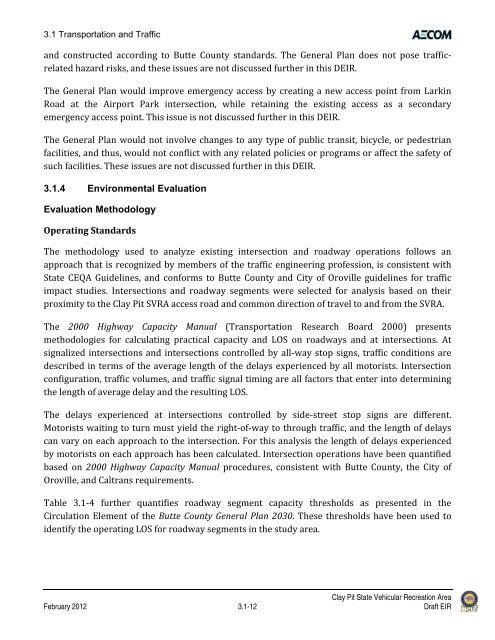Draft Environmental Impact Report - California Off Highway Vehicle ...
Draft Environmental Impact Report - California Off Highway Vehicle ...
Draft Environmental Impact Report - California Off Highway Vehicle ...
Create successful ePaper yourself
Turn your PDF publications into a flip-book with our unique Google optimized e-Paper software.
3.1 Transportation and Traffic<br />
and constructed according to Butte County standards. The General Plan does not pose traffic‐<br />
related hazard risks, and these issues are not discussed further in this DEIR.<br />
The General Plan would improve emergency access by creating a new access point from Larkin<br />
Road at the Airport Park intersection, while retaining the existing access as a secondary<br />
emergency access point. This issue is not discussed further in this DEIR.<br />
The General Plan would not involve changes to any type of public transit, bicycle, or pedestrian<br />
facilities, and thus, would not conflict with any related policies or programs or affect the safety of<br />
such facilities. These issues are not discussed further in this DEIR.<br />
3.1.4 <strong>Environmental</strong> Evaluation<br />
Evaluation Methodology<br />
Operating Standards<br />
The methodology used to analyze existing intersection and roadway operations follows an<br />
approach that is recognized by members of the traffic engineering profession, is consistent with<br />
State CEQA Guidelines, and conforms to Butte County and City of Oroville guidelines for traffic<br />
impact studies. Intersections and roadway segments were selected for analysis based on their<br />
proximity to the Clay Pit SVRA access road and common direction of travel to and from the SVRA.<br />
The 2000 <strong>Highway</strong> Capacity Manual (Transportation Research Board 2000) presents<br />
methodologies for calculating practical capacity and LOS on roadways and at intersections. At<br />
signalized intersections and intersections controlled by all‐way stop signs, traffic conditions are<br />
described in terms of the average length of the delays experienced by all motorists. Intersection<br />
configuration, traffic volumes, and traffic signal timing are all factors that enter into determining<br />
the length of average delay and the resulting LOS.<br />
The delays experienced at intersections controlled by side‐street stop signs are different.<br />
Motorists waiting to turn must yield the right‐of‐way to through traffic, and the length of delays<br />
can vary on each approach to the intersection. For this analysis the length of delays experienced<br />
by motorists on each approach has been calculated. Intersection operations have been quantified<br />
based on 2000 <strong>Highway</strong> Capacity Manual procedures, consistent with Butte County, the City of<br />
Oroville, and Caltrans requirements.<br />
Table 3.1‐4 further quantifies roadway segment capacity thresholds as presented in the<br />
Circulation Element of the Butte County General Plan 2030. These thresholds have been used to<br />
identify the operating LOS for roadway segments in the study area.<br />
Clay Pit State Vehicular Recreation Area<br />
February 2012 3.1-12 <strong>Draft</strong> EIR








